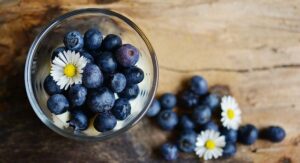Chicken Lemon Rice Soup
It’s soup season here in the Midwest. The high today was something like 11°F. Brrrrr.
Grateful that it was sunny.
Since we’re probably going to have a few more days like this, I’ve decided to share a soup recipe with you. 
I am aware that this recipe does not fall in line with authentic Greek recipes for lemon rice soup, however since I’m not Greek, I figured I can get away with it.
It’s easy to make. It takes time to cook because brown rice takes longer to cook than white rice. By using brown rice, the fiber intake is greater, and with the addition of the chicken, you get more protein. Bone broth will also add more protein and additional health benefits, especially if it’s homemade.
I think I’ll be making a batch this weekend.
Chicken Lemon Rice Soup
- 7 cups organic chicken broth or bone broth
- 1 small onion, peeled and cut in half
- 1 small carrot, peeled and chopped in small pieces
- 1 bay leaf
- 1/2 teaspoon salt
- 2 boneless, skinless chicken breasts
- 1 cup organic brown rice
- 2 eggs
- ½ cup freshly squeezed lemon juice
- 2 tablespoons finely chopped parsley (optional)
- Ground black pepper to taste
Bring chicken broth, onion, carrot, bay leaf and salt to a simmer. Add chicken breasts, cover and gently simmer over low heat for 20-30 minutes, until chicken is cooked. Remove chicken breasts, let cool slightly and pull or cut chicken into thin strips. Set aside. Remove onion pieces and bay leaf from soup and return to boil. Add rice and gently simmer for about 40 minutes, then add chicken back to soup for another 5 minutes.
Whisk eggs until they are frothy, then whisk in lemon juice. Add a cup of the hot soup to egg-lemon mixture, very slowly, whisking while you pour it in. Add another cup in the same manner. Take soup off the heat and add egg mixture to it. Sprinkle with parsley if desired, season with pepper and serve. Makes about 4 servings.
Bon appétit,
Health Coach Carol
“To feel safe and warm on a cold wet night all you really need is soup.”—Laurie Colwin








